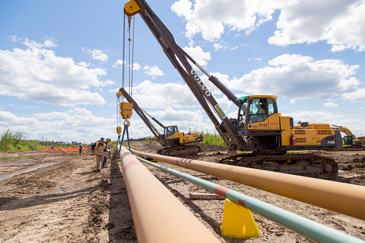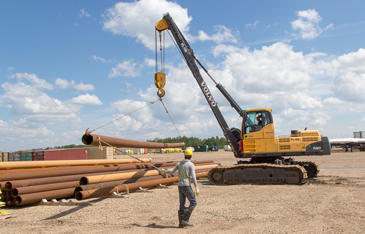Surerus Pipeline Inc. is working at the Long Lake Kinosis project installing three 10km pipelines, two of which use thermal traced technology, using Volvo construction equipment.
Just south of Fort McMurray, 60 km west of the Saskatchewan border, the province of Alberta is recognized as the oil capital of Canada. Alberta contains nearly all of Canada’s oil-sands (crude bitumen) and much of its conventional oil reserves, accounting for 98% of the country’s entire production. Today, most of Canada’s petroleum production – approximately 283,000 m3 a day – is exported, making Canada the largest single source of oil imports into the US.
Surerus Pipeline Inc., one of Canada’s major pipeline companies, is strategically located in the heartland of Canada’s oil and gas exploration industry. The company recently won the Long Lake Kinosis project contract from giant energy developer, Nexen Canada – a wholly-owned subsidiary of CNOOC – China’s largest producer of offshore crude oil and natural gas. Nexen employs 3,200 people worldwide, developing energy resources globally and has been producing crude oil from bitumen since 2009.
The $6.1 billion (EUR 5 billion) Long Lake Kinosis project is located at one of Nexen’s integrated Steam Assisted Gravity Drainage (SAGD) bitumen recovery sites and upgrading operations. Long Lake has a production capacity of an estimated 72,000 barrels of oil a day and work is underway to increase its bitumen production.
The particulars of this project includes the installation of three pipelines, two of which use thermal traced Pipe-In-Pipe (PIP) technology designed and provided by French company, InTerPipe (ITP).The three pipes consist of one outbound hot fluids 16-inch pipe inside a 20-inch pipe used to transport fluids from Kinosis to Long Lake, one 12-inch pipe inside a 16- inch pipe that transports boiler feed water from Long Lake to Kinosis (known as the recovery line), and one standard oil pipe – all running about 10 km in length. This thermal technology is primarily used for lay barges, subsea pipelines and land-to-sea pipelines.
The method requires the production of insulated pipe to be custom fabricated and assembled onsite, or at ITP’s facility, so the pipe line can be pieced together. In this instance, Surerus built a new 2,787 m2 (30,000 ft2) building in Gibbons, Alberta, just to manage the assembly of the pipes. Because the pipe-in-pipe lines are twice as heavy and cannot be bent or roped in the traditional way, the trench must be dug much deeper in certain places. For this deeper trenching, Surerus purchased a Volvo Construction Equipment (Volvo CE) EC700C excavator that handles trenching, mass excavation, quarry loading, rock-face stripping, mining, earthmoving and material loading.
Laying down the law
In 2012, Surerus bought its first Volvo PL3005D pipelayer and a few months later added seven more units to its fleet, including two PL3005D models, three PL4608 and two PL4611 models.
Weight would normally be an issue but Volvo CE’s PL4608 and PL4611 rotating pipelayers have respective tipping capacities of 80 tonnes and 110 tonnes, featuring on-board load management systems. Where the trenches are deep, the hydraulic elevating cab on the PL4608, and fixed raised cab on the PL4611, both increase visibility for operators.
“The extra height from the fixed raised cab on the Volvo PL4611 and long reach feature is ideal in this type of stacking or unloading application,” says Brian Surerus, eponymous owner of Surerus Pipeline Inc., established in 1969. “The Volvo pipelayers are safe, efficient, purpose‑built machines that are superior to traditional side boom dozers units for many applications. The 80 tonne tipping capacity and on- board load management system of the PL4608 handles the weight with ease while the hydraulic elevating cab significantly increases operator visibility.”
“After years of operating a traditional side boom dozer for pipelaying, the change from the previous machine to this one was a completely new experience,” says veteran operator Rick Gould. “They are versatile – you can literally off load the pipe and swing it 180 degrees to the trench and you can’t do that with a side boom dozer. Operator visibility is outstanding, making it safer for the operator and the ground crew. It has superior reach and the on-board load management system is fantastic. As for the cab, who wouldn’t like the air conditioning, heating and stereo.” (Unlike side boom dozers that generally have only a rudimentary cab, if one at all.)
The Kinosis project is the first time this PIP technology has been used exclusively for a land-based pipeline and is one of a kind in North America. Oil is expected to flow through the new pipeline in the autumn of 2014 and if work goes to plan, the technology is expected to become the most popular method for the extraction and transport of heavy oil and gas in the region.
Source: Volvo CE
 Constructionshows
Constructionshows

